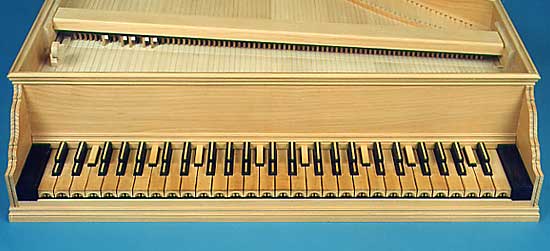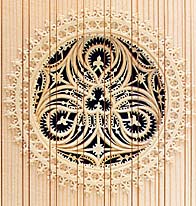ROMAN HARPSICHORDS
Roman harpsichords used spruce (or fir) more often than cypress for the soundboard. The stringing is usually of brass so a bright, bold sound is the result. 16th-century harpsichords are rare and 17th-century instruments are represented through the work of Boni, Albana, Faber, Zenti, Ridolfi, and Giusti. The work of Giusti has become well known through the availability of two museum drawings, the 1681 and 1693 (previously anonymous) harpsichords in the Germanisches Nationalmuseum, Nuremberg and National Museum of American History, Smithsonian Institution. Washington DC respectively.
A cimbalo cromatico reconstructing Faber's (also Fabbri, Fabri) 1631 instrument, C/E-c³, 8' (sometimes called cembalo cromatico)
This is one of only three surviving Italian harpsichord keyboards known originally to have had 19 notes per octave. For details of the others, see my checklist of instruments with split sharps available here as a download. It has a normal C/E bass octave but with F# and G#. The first chromatic note is B#, thereafter all chromatic notes are available with split sharps until f² when it reverts to a standard compass. According to one definition of the enharmonic genus, it would be possible to refer to this as an enharmonic harpsichord. This uses brass stringing with a spruce soundboard.

This is not the Faber harpsichord but a special instrument made for Christopher Stembridge, with selectable chromatic or short octave in the bass, i.e. C-d³ or C/E-d³, and 19-note division in the octave, who plays it on the CD Consonanze Stravaganti, Neapolitan music for organ, harpsichord, and chromatic harpsichord (Ars Musici AM 1207-2). ![]()
click here to order from www.amazon.com
A Roman harpsichord after Albana (1628-1645) GG/BB-c³, 8'+8'+8'
Based on the Metropolitan Museum, New York, #45.41 which I have attributed to Albana, this reconstructs the original disposition with three 8' registers which would have presumably been used for ensemble playing. Strung in brass wire this sounds at the Roman pitch of c.390 Hz. It is an inner-outer instrument with a spruce soundboard.

An inner-outer style instrument from one of the most renowned 17th-century Italian makers, who worked for the Swedish and French royalty with spruce soundboard and brass stringing. The rose is made of parchment in a style characteristic of those found in Zenti instruments. This is one of the lesser-known Zenti harpsichords.
A Roman harpsichord after Giusti (1677 and 1681) C/E-c³, 8'+8'
This is based on the Halle and Nuremberg instruments and made in the "false-inner-outer" fashion with a spruce soundboard. With brass strings the pitch is a' = 415Hz.
A Roman harpsichord after Giusti (1677 and 1681) C,D-d³ for modern use
This instrument is based on the previous Giusti instruments and made with the larger compass as he might have done in order to provide a practical instrument for the modern performer. One Italian instrument was even altered from a GG/BB-c³ compass before our time to give exactly this range. Pitch a' = 415Hz and 440Hz with a transposing keyboard.
A Roman harpsichord after Giusti c.1681/1693 GG,AA-d³, 8'+8'
Few Italian harpsichords were originally made with a compass reaching to d³, a compass which has become popular in the recent harpsichord revival. However the harpsichord I have attributed to Giusti (c.1681; now bearing a faked inscription to Baffo and altered into a two-manual instrument) appears to have had this compass and I offer this instrument in a "false-inner-outer" style for the convenience of the travelling musician. I described the attribution of the similar 1693 harpsichord (GG,AA-c³) in the Smithsonian Institution, Washington, DC, in my monograph. See my Publications 1992/3.